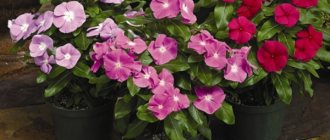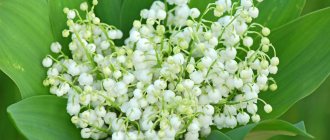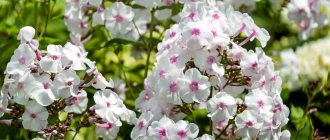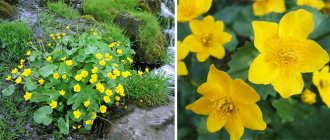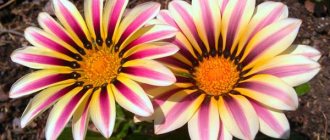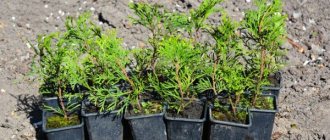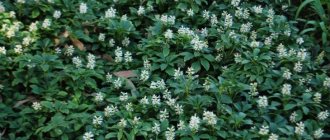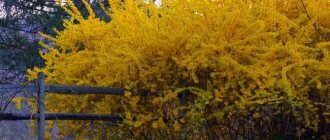Contents
- Description
- Popular hybrids and varieties
- Landing
- Swamp Hibiscus Care
- Propagation by seeds
- Reproduction by dividing the bush
- Propagation by cuttings
- Diseases and pests
Hibiscus are one of the most spectacular and popular tropical plants. The genus contains more than 200 species native to temperate, subtropical or tropical regions of the world. Some of them are highly decorative and are cultivated as garden and indoor plants.
In temperate climates, due to their hardiness and valuable decorative qualities, only two species have become widespread: tree hibiscus and herbaceous garden hibiscus, the cultivation and care of which is not difficult.
Herbaceous hibiscus (Hibiscus Moscheutos), also known as “swamp hibiscus” or “pink mallow,” has provided gardeners with numerous magnificent varietal forms and hybrids.
Description
The plant is a branched bush, which in favorable conditions can reach a height of about two meters over the summer. The above-ground part dies off in winter, but the root system easily tolerates frost, producing new shoots in the spring.
The leaves are broadly ovate, palm-shaped or dissected, similar to maple, green or with a purple-burgundy tint, depending on the variety.
Unlike its tree cousin, this species is characterized by a longer flowering period and huge flowers (up to 27 cm in diameter) in white, pink, red, cherry, scarlet, peach, often with a contrasting core and long stamens.
Each flower lasts 1-2 days, but new flowers open each day in quick succession until late in the season. At its peak, a large bush may produce 20 or more flowers per day.
Useful video
To learn how to properly transplant hibiscus, watch the following video:
If you find an error, please select a piece of text and press Ctrl+Enter.
I transplant adult hibiscus into larger pots at the end of April. I prepare the nutrient mixture for them the same as for transplanting rooted cuttings.
I trim all the shoots of the plant, and cut off the branches of the Chinese rose that have become very elongated during the winter by a third of their length to stimulate the formation of young shoots that will bloom.
During active growth and flowering, I water the hibiscus generously. I periodically apply fertilizers in the form of aqueous solutions.
It is also useful to feed the Chinese rose with a weak solution of sugar syrup (0.5 teaspoon of sugar per glass of water). If you defrosted meat and found at least 1 tbsp. spoon of blood, then dilute the blood with water and water your Chinese rose, it will benefit it: hibiscus loves the nutrients contained in the blood.
Chinese rose is a very light-loving plant, but direct hot sunlight is harmful to it and causes burns. Hibiscus can grow in the garden in summer, in a place protected from the hot midday sun. I take the hibiscus out into the fresh air under a canopy for the summer. You can place the plant on the balcony with cover from the hot sun.
However, if you didn’t keep track, and your Chinese rose is still baked in the sun, then for treatment, make the sweet solution described above and wipe all the leaves of the plant with it. Sun-baked hibiscus leaves should be wiped with a sugar solution every day until the leaves damaged by burns are completely restored. Don't worry - there will be no midges from using the sweet solution: the leaves of the Chinese rose quickly absorb the sugar.
When the Chinese rose is blooming, I spray it with warm water; The plant especially needs spraying in hot summers, when the air is very dry.
In winter, I keep my hibiscus in a cool room, in a well-lit place. I water the Chinese rose little during the dormant period. Blooming Chinese rose in autumn and winter
When kept in favorable conditions and with proper care, hibiscus blooms from early spring to autumn, and with sufficient lighting it blooms successfully in winter.
- How to replant a Chinese rose
- How to pinch an azalea
- Hibiscus at home: cultivation and care
- - pots,
- - soil mixture,
- - expanded clay,
- - charcoal,
- - scissors for cutting branches,
- - support stick,
- - polyethylene film.
In summer, the Chinese rose can be placed on the balcony, because the flower requires a lot of light.
If you regularly fertilize and water your hibiscus, it will often delight you with beautiful large flowers.
- - Chinese rose cuttings;
- — expanded clay;
- - peat soil;
- - leaf soil;
- - sand;
- - turf land;
- - humus soil.
- Chinese rose
Popular hybrids and varieties of herbaceous hibiscus with photos
“Blue River” - the petals of the variety are snow-white with a slight blue tint and “Old Yella” with a lemon tint;
"Carousel", a magnificent varietal collection with giant flowers, abundant flowering and burgundy-green dissected foliage, is distinguished by its unpretentiousness and winter hardiness. The series includes three varieties - “Merry Heart” with large white flowers and bright crimson and purple “Red Wine”.
'Jazzberry Jam' has purple-pink blooms.
Plants of the Luna series are low-growing, unpretentious varieties. Cultivars: 'Moon Red', 'Moon White' and 'Moon Pink Swirl' with pink and white petals.
Hibiscus hybrid "Robert Fleming" is a compact shrub with velvety, red flowers 24 cm in diameter. Continuous flowering from July to late August.
Hybrid hibiscus “Fireball” with bright red numerous flowers with a diameter of 25 cm. The height of the bush is about 1.5 meters, winter hardiness down to minus 35 °C.
The Summerific collection is represented by several cultivars:
'Cranberry Crush' has scarlet blooms from early August to October and purple-green leaves;
"Summer Storm" - magnificent huge white and pink flowers against a background of green and purple foliage;
"Berry Awesome" is a low-growing bush with dark pink flowers;
“Cherry Cheesecake” - spectacular cherry-white color of the petals;
'My Valentine' is a compact bush with huge bright red flowers;
'Midnight Marvel' - intense red blooms against violet-purple foliage;
Planting herbaceous hibiscus
For planting, it is best to purchase seedlings in containers, which quickly take root and adapt to a new location. Can be planted at any time from late spring to mid-September. Saplings with an open root system are usually planted after dividing the bush in early May.
Avoid planting swamp hibiscus on hot, dry days, as the plant may suffer temperature shock during the procedure. In such weather it is better to land in the evening.
This species is moisture-loving, so it grows well near ponds or in damp areas of the garden. Choose a place protected from the wind, sunny or light partial shade. A sunny position stimulates the formation of large and numerous flowers and helps to avoid fungal diseases.
The soil for growing herbaceous garden hibiscus should be neutral, rich in humus and permeable. This species adapts to different types of soil, but a fertile substrate promotes good growth and flowering.
Before planting the plant, at the bottom of the planting hole, pour a 7-10 cm layer of compost or humus, a little ash, a tablespoon of superphosphate, and a thin layer of earth on top. Then place the root ball, fill the hole and water well. At first, make sure that the soil around the seedlings is moderately moist at all times.
Spring planting of trees and shrubs
To prevent moisture from evaporating and the roots from overheating, the soil around the bush is mulched with a layer of compost or pine bark. Since many varieties, except dwarf ones, tend to grow, when planting, leave enough space between the seedlings, approximately 1.5-2 meters depending on the varietal shape.
Agricultural technology of hybrid hibiscus
Choose a place for planting flowers that is bright and protected from the cold wind. It should be noted that each bush consists of several erect trunks, on which additional branching is created by pruning. Therefore, initially the bushes are planted at a distance of a meter from each other. It is a wonderful hedge and background for other flowers. The bushes are perennial, and with the replacement of the top layer of soil in one place they can grow for many years. The plant loves well-drained loam. Does not tolerate close proximity to groundwater and calcareous soil.
A plant planted in a low area will certainly get wet in the spring. If the site leaves no options, the planting site must be raised and a drainage substrate must be installed below.
Herbaceous hibiscus loves:
- shower with leaves, but only in the mornings and evenings, when the sun is weak;
- watering in moderation, without drying out the soil;
- fertilizing once every two weeks with complete fertilizer, taking into account biology in each period;
- loosening is frequent, but superficial.
If all conditions are met, the flower will delight you for a long time with tropical flowers of unprecedented size.
Features of caring for swamp hibiscus
Watering is a major factor in growing herbaceous hibiscus. With the beginning of active growth, the bush is irrigated abundantly 2-3 times a week. On cold and rainy days there is no need to water. In hot weather, water more often. Monitor the condition of the bush - the plant reacts to moisture deficiency by dropping buds and withering foliage.
Some varieties with a well-developed root system are quite resistant to short-term drought. The varietal forms of the Luna series are especially hardy.
Feed the plant in the spring at the beginning of the growing season with organic fertilizer. In September, you can add ash diluted in water under the bush. To prolong flowering, regularly remove spent flowers.
Perennial mallow - planting and care
After the first frost, the above-ground part of the bush dies. At the end of autumn, the shoots are cut almost to ground level, and the bush itself is well watered and covered with soil, spruce branches or fallen leaves.
Timing of cuttings of hibiscus
The ideal time for formative pruning is early spring. Even before the first buds appear on the bush, you need to cut off the shoots of the previous year. A good cutting should have at least 3 buds. In this case, the chances for rapid rooting and favorable development of the bush are maximum.
Hibiscus tree garden: care and cultivation
The second option for propagating hibiscus by cuttings at home is in the summer months. Since the intensity of natural light is at its highest at this time, you can do without a container of water. For propagation, a shoot with several rows of leaves and no buds is selected, and then it is carefully cut off.
On a note! After dusting the cut with any root formation stimulator, the cutting is immediately planted in the prepared pot. After a couple of weeks, with successful rooting, new leaves will appear at the top. This will be a signal that the shoot has taken root in a new place and it’s time for it to pinch off the top.
Herbaceous hibiscus from seeds
Seeds of this species have a high germination rate, and seedlings are characterized by rapid growth. To undergo stratification before sowing in spring, mix the seeds with damp sand and store them in the refrigerator for 60 days.
Immediately before planting, the seeds are soaked in warm water for a day. Sow at the beginning of March in a damp mixture of sand and peat to a depth of 3-4 mm and cover with film.
The optimal temperature for germination is 20-23 °C. Keep the substrate moderately moist with a water spray and ventilate the greenhouse periodically.
After germination, remove the cover and continue to grow herbaceous hibiscus in the same pot for 5 weeks. At the stage of 2-3 leaves, the seedlings dive and a month later the first fertilizing is carried out with a weak solution of a balanced fertilizer with a predominant nitrogen content. Then feed at every third watering.
They are planted in open ground at the beginning of summer and do not allow the soil to dry out, since the root system of young plants is very sensitive to lack of moisture. To stimulate tillering, it is useful to pinch the tips of the shoots as they grow.
Basic information about the plant
The herbaceous variety of hibiscus is a perennial plant that was created by crossing several North American varieties. This made it possible to endow the flower with resistance to severe frosts and summer drought. Good survival rate and undemanding conditions for care have ensured the widespread distribution of hibiscus.
With the onset of cold weather, the branches of the plant are cut off almost to ground level. The branched root system ensures the rapid growth of hibiscus in the spring, the formation of a young crown and buds. The height of the shoots can reach 3 meters. Flowering begins in mid-summer and continues until the first frost (mid-late October). The inflorescences sometimes reach a diameter of 30 cm, which is comparable to the size of a soccer ball.
A photo of a herbal hibiscus bush will help you imagine all the beauty of this plant. It may well become the central point of any composition, since the petals can be of different colors (the only exceptions are black and blue). There are varieties where the petals are painted in a combination of two shades. Moreover, their edges can be terry or corrugated. Varieties that are distinguished by unusual colors are best planted in areas with a warm climate where mild winters are observed.
Propagation of herbaceous hibiscus by cuttings
As soon as the young shoots reach a height of about a meter, cut cuttings 25 cm long and place them in water to form roots. The water is changed frequently so that it does not stagnate.
When the roots are formed, the plants are planted in open ground.
Diseases and pests
Hibiscus often suffers from attacks by spider mites, aphids and whiteflies. If not properly cared for, chlorosis may occur .
Fighting methods
Chlorosis is caused by a lack of iron and excess chlorine in irrigation water . It is expressed in yellowing and falling leaves.
Spraying with chelated iron helps to cope with this disease .
When whiteflies and aphids appear on the plant, spraying with insecticides (Aktara, Intavir, Kinmiks) will help.
If you plant lavender or marigolds next to hibiscus, aphids will not appear.
also destroys aphids well . You can use glue traps and spraying with dandelion infusion against whiteflies. Spider mites are afraid of soapy water and chemicals (Aktofit, Vermitek).
Growing herbaceous hibiscus in your garden is not difficult. With minimal care, this plant will delight the eye for a long time with its unforgettable flowering.
